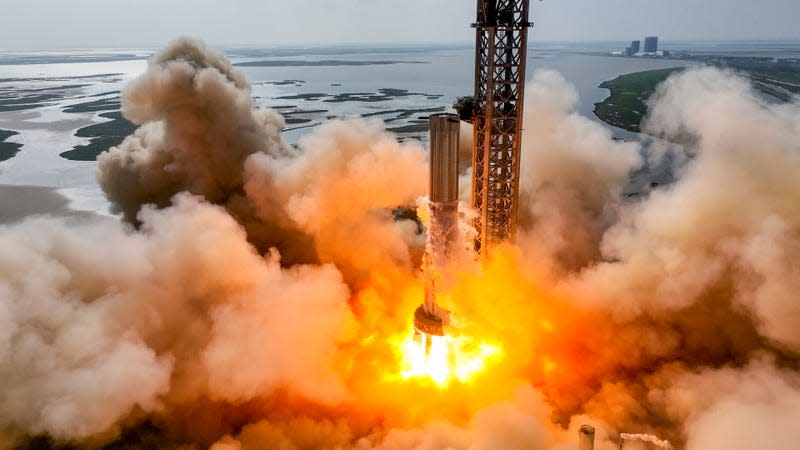Latest Test of Gigantic Starship Booster Takes SpaceX Closer to Launch

- Oops!Something went wrong.Please try again later.
Yesterday, SpaceX performed a static fire test of a prototype booster in which 11 of its 33 Raptor engines were briefly engaged. The private company could very well be on target to launch the fully stacked Starship system next month.
The 13-second static fire test happened on Tuesday at 2:24 p.m ET at SpaceX’s test facility in Boca Chica, Texas. As usual, a video crew from the news site NASASpaceflight was there to document the test of the Booster 7 prototype. You can watch a replay at the video link below, with the engine firing starting at the 4:34:20 mark (be sure to crank the volume).
Read more
SpaceX Static Fire of Super Heavy Booster 7
SpaceX later confirmed via Twitter that 11 of the booster’s 33 engines fired during the test. The company didn’t disclose the total power of the test, but assuming each engine was engaged at full throttle, that amounts to approximately 5.61 million pounds of thrust. All 33 Raptor 2 engines are expected to produce around three times that power. During the previous static fire test on November 14, ground teams engaged 14 booster engines.
CEO Elon Musk chimed in shortly thereafter, saying “possibly one more static fire” test of the booster might be required and “then orbital launch attempt.” It’s important to take these words with a grain of salt, of course, as Musk tends to overpromise when it comes to timelines. Earlier this year, for example, Musk said the fully integrated rocket would perform its first orbital launch in July.
Next test is ~20 sec firing with max oxygen fill to test autogenous pressurization, possibly one more static fire, then orbital launch attempt
— Elon Musk (@elonmusk) November 15, 2022
The booster’s upper stage, the Starship spacecraft (specifically Starship 24), is ready to go, as SpaceX already tested its six Raptors on September 8. The current plan is to launch the fully stacked Starship in December, at which time the upper stage will enter orbit but not complete a full revolution of Earth.
Once aloft, Starship will become the most powerful rocket in the world, snatching away the title currently held by NASA’s Space Launch System (SLS), which finally launched on November 16 as part of the Artemis 1 mission. SLS blasted off with 8.8 million pounds of thrust, whereas Starship is expected to launch with 16.7 million pounds of thrust.
SpaceX envisions Starship as a means to launch cargo and people to space, whether it be to low Earth orbit, the Moon, or Mars. The private company is currently under contract with NASA to modify Starship such that it’s capable of serving as a lunar lander for the Artemis missions to the Moon.
More: SpaceX Awarded $1.15 Billion Contract to Build NASA’s Second Lunar Lander
More from Gizmodo
Sign up for Gizmodo's Newsletter. For the latest news, Facebook, Twitter and Instagram.

